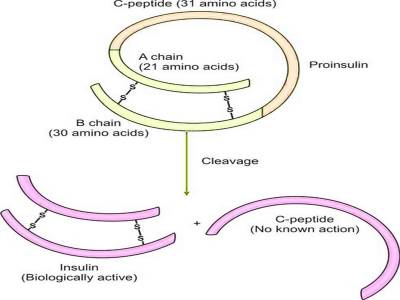Metabolic Effects of Insulin

Insulin is the major hormone regulating blood glucose level. Insulin is synthesized by β cells of pancreas as preproinsulin, which is rapidly converted to proinsulin. Proinsulin is a single chain polypeptide. In the Golgi apparatus, proinsulin is broken down into 2 units- insulin (51 amino acids) and C (connecting)-polypeptide (31 amino acids) (Figure 1192.1).
Both insulin and C peptide are stored in membrane-bound granules in the cytoplasm of β cells. Upon stimulation (mainly by blood glucose), both insulin and C peptide are released in circulation. C peptide is often measured as a marker of activity of β cells. C peptide has no known function.
Insulin acts on various cells (especially those of liver, muscle, and adipose tissue) through receptors.
“Stress hormones” like glucagons, glucocorticoids, growth hormone, and adrenaline oppose action of insulin.
Important actions of insulin are listed below.
- Increases:
– Uptake of glucose in skeletal muscle and adipose tissue
– Glycogenesis in liver and muscle
– Fatty acid and triglycerides in liver and adipose tissue
– Protein synthesis in liver and muscle - Decreases:
– Gluconeogenesis in liver
– Glycogenolysis in liver and muscle
– Lipolysis in adipose tissue
– Ketogenesis in liver
- Comment
- Posted by Dayyal Dg.